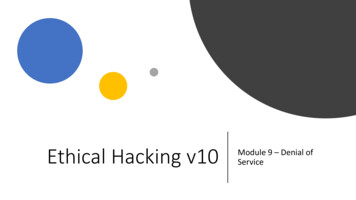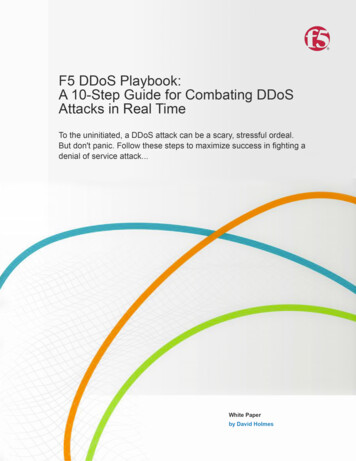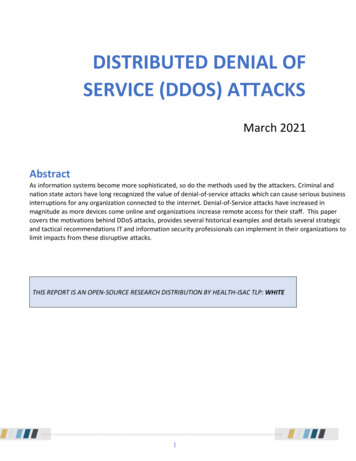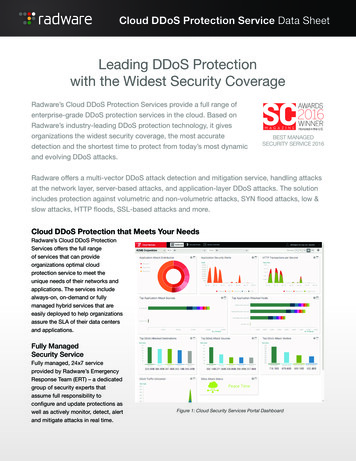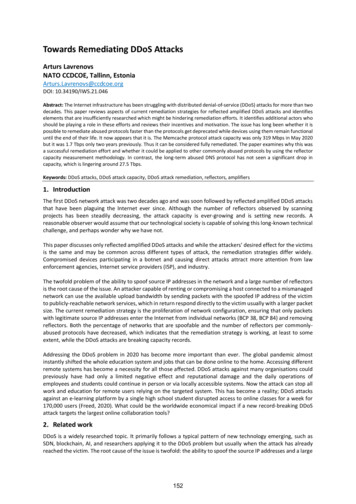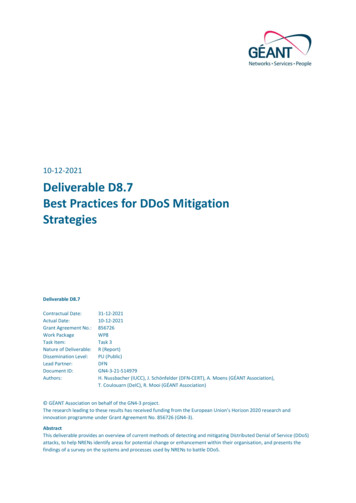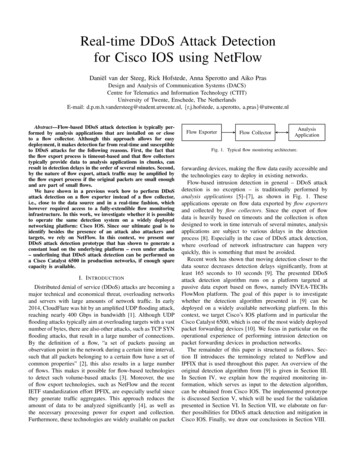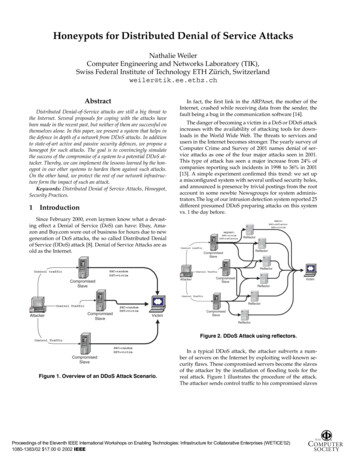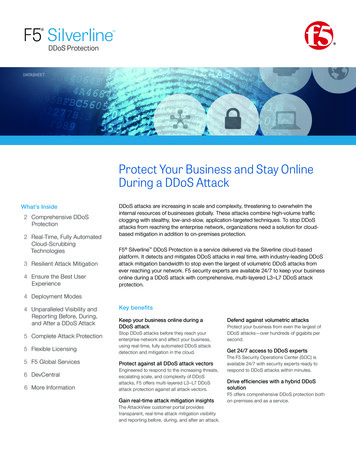
Transcription
A BUSINESS WHITEPAPER FROM NSFOCUSDISTRIBUTEDDENIAL-OF-SERVICE(DDoS) ATTACKS:AN ECONOMICPERSPECTIVE
Table of ContentsIntroduction . 3A Distributed Denial-of-Service Primer . 4Volumetric based attacks . 4Application based attacks . 4Threat Actors, Attack Vectors and Motivations – What drives DDoS Attacks? . 4The Financial Impact of Distributed Denial-of-Service Attacks . 5Direct Costs. 5Indirect Costs . 7A Closer Look At The Cost of Distributed Denial-of-Service Attacks . 8DDoS Attack Cost Model . 8Example: Online Retail . 9Example: Software Development . 12Return on Investment: A Three Year Cost Analysis . 13Conclusion . 14The Economics of DDoS Attacks: A Macro View . 15Summary . 15Executive SummarySenior executives are wisely paying attention to Distributed Denial-of-Service (DDoS)attacks, since the financial consequences can be significant. A comprehensive analysisof the financial impact of a DDoS attack should include both direct and indirect costs,bearing in mind that the cost of a DDoS attack is closely tied to the duration and type ofattack itself.This paper presents a model that can be used to estimate costs and return-oninvestment (ROI) based on the specifics of each situation.Payback for DDoS protection solutions can range from immediate to less than 6 months,,depending on the features, cost and performance of the chosen solution.In light of the fact that macro trends point to a continuing rise in the frequency anddamage from DDoS attacks, a model such as this becomes increasingly important.2
IntroductionWhile network security experts disagree on when the first Distributed-Denial-of-Service (DDoS)attack occurred, it is generally conceded that the most visible series of attacks occurred in February of2000 when Internet giants Yahoo, Amazon, eBay, E-trade and others were attacked intermittently overa period of several days. The Yankee Group estimated the total cumulative costs of these attacks at 1.2 Billion U.S. Dollars, and it was later discovered that the attacks were conducted by a 15-year oldCanadian teenager using the alias “Mafiaboy”. The teenager had crafted the series of attacks usingseveral publicly available hacker tools.1More than fourteen years later, DDoS attacks are more frequent, complex and destructive thanever. The threat actor landscape has expanded from a single individual with a hobby and an agenda toinclude cyber-terrorists, professional hackers/crackers/phreakers, hostile nation states, rivalcompanies and even unwitting employees, customers, partners and private citizens. Today, there hasbeen an explosion in connectivity ushered in by mobile and cloud computing, coupled with theavailability of sophisticated but easy-to-use DDoS tools and the rapid commoditization of networkbandwidth. As a result, it has never been easier to launch a sustained attack designed to debilitate,humiliate or steal from any company or organization connected to the Internet. These attacks oftenthreaten the availability of both network and application resources, and result in loss of revenue, lossof customers, damage to brand and theft of vital data.Fortunately, DDoS mitigation techniques have also evolved; today, the DDoS mitigation marketcomprises dozens of companies who collectively invest billions of dollars in the research anddevelopment of advanced countermeasures. The accuracy and effectiveness of these solutionscertainly differ, but there is no denying that specialized DDoS technology is being deployed byorganizations of all sizes in order to insulate themselves against this growing threat.This paper examines the financial impact of modern DDoS attacks by describing the coststypically incurred by the victims of these attacks. It summarizes publicly-available information andresearch about the scope and costs of recent high-profile attacks, and provides a model that can beused to measure the impact of a DDoS attack for your own organization. While all of the costs in themodel may not directly apply to your specific business or organization, they are presented to provide acomplete picture of the expenses to consider when evaluating the purchase of DDoS protection.Finally, this paper discusses the larger economic factors that will continue to fuel the proliferation ofthese types of attacks for the foreseeable future.1SANS Institute, “The Changing Face of Distributed Denial-of-Service Mitigation, 20013
A Distributed Denial-of-Service PrimerDDoS attacks are an attempt to exhaust network, server or application resources so that they are nolonger available to intended users. These attacks generally fall into two categories:Volumetric based attacksThese attacks are characterized by the presence of an abnormal and overwhelming number ofpackets on the network. Threat actors attempt to consume all available network bandwidth and/orexhaust router, switch and server forwarding capacity by flooding these devices with malicious trafficso that legitimate user traffic is starved. Some examples of volumetric based attacks include UDP,ICMP and SYN flood attacks.Application-based attacksApplication-based attacks are designed to exploit weaknesses or software defects that exist inthe protocols and applications themselves. They attempt to disrupt service by consuming CPU,memory or storage resources in target servers that are running the application so that the applicationis no longer able to serve legitimate users. They may also attempt to crash the application by supplyingmalformed messages or unanticipated input to the application. Some examples of application attacksinclude HTTP GET/POST attacks, SIP header manipulation attacks and SQL injection attacks.Hybrid attacksModern DDoS attacks are very sophisticated and often blend several volumetric and applicationbased attacks in order to disrupt service. These so called “hybrid” attacks attempt to consume allnetwork bandwidth while simultaneously exhausting server resources. Frequently these attacks areused to not only create a catastrophic denial of service condition but also distract security operationspersonnel from other malicious activity such as the installation of backdoors or other advancedpersistent threats (APT) tools designed to steal vital data. Another common attack technique is toprobe an organization’s DDoS response capabilities using a series of short duration attacks over alonger period of time in order to craft a site-specific plan designed to circumvent existing DDoSprotection solutions.Threat Actors, Attack Vectors and Motivations – What drives DDoS Attacks?Who is performing these attacks (threat actors), what means do they use (threat vectors) and what istheir motivation?The answers to these questions are as varied as the attacks themselves. Threat actors can include exemployees, current employees, hobbyists, political activists (hacktivists), professional hackers (hackersfor-hire), competitors, hostile nation states or vandals who simply enjoy creating chaos.4
These attackers can use a seemingly infinite number of devices and protocols as a means to carryout their attacks. Sophisticated and large virtual networks of compromised computers, mobile phones,internet connected smart devices (IoT/home automation), infrastructure servers, home routers, UnifiedCommunications systems and almost anything that is internet connected could be controlled bymalicious attackers to launch directed and sustained attack campaigns. These so called “botnets” or“zombie armies” will use a diverse set of protocols typically found at layers 3, 4 and 7 of the OpenSystems Interconnection Model (OSI) to carry out the attacks. A non-inclusive list of these protocolsincludes TCP, UDP, ICMP, NTP, SSDP, HTTP, DNS, SNMP, FTP and more. Attackers can exploit the mannerin which the protocols work as well as software defects in their implementation to disrupt servicedelivery. These protocols and devices are the threat vectors to consider when designing an effectiveDDoS mitigation strategy.Motivations for DDoS attacks tend to be financial, philosophical or political in nature. Typicalmotivations include blackmail/extortion, political or ideological disputes, revenge, vandalism, anattempt to gain a competitive advantage in a business rivalry or an attempt to cover up or distractfrom other exfiltration or theft of data activities. Regardless of the motivation, it is clear that if you areconnected to the Internet or rely on the internet to conduct your business operations you can be atarget. The significance of the DDoS threat has not gone unnoticed: a recent survey of more than 641IT security and operations professionals revealed that 38% of respondents ranked Denial-of-Serviceattacks as their most significant IT security concern, placing this class of attack in the top 3 out of 10overall IT security threats.2The Financial Impact of Distributed Denial-of-Service AttacksIn any DDoS attack there are both direct and indirect costs to the victim. Direct costs, ingeneral, are easier to measure and can be immediately associated with the attack. Indirect costs, onthe other hand, are more difficult to identify and their effects are often not felt for weeks, months or insome cases years following the actual attack itself.Direct CostsLoss of revenue: This is usually the most straightforward metric to collect, particularly if your primarybusiness is electronic commerce. Online retailers, streaming media services, online gaming, businessto business hubs, online marketplaces, Internet based advertisers and internet commerce businessesare among those that experience direct revenue loss with any disruption of service. These companiestypically measure revenue in clicks or impressions per minute or average revenue per minute ortransaction. Revenue is completely lost for the duration of any attack that takes them completelyoffline, or can be severely reduced during periods when their online systems are performing outside oftheir normal operating level.2Ponemon Institute, “The Cost of Denial-of-Services Attacks”, March 20155
Loss of productivity: Many companies and organizations use theirnetwork, online resources and publicly-available services tosupport their primary business. Any disruption to the availabilityof these important resources results in a loss of productivity.Whether employees are accessing the Internet, performingsoftware tasks on remote servers, transferring or accessingvaluable company data rem resulted in a complete outage of their online store and the theft of vital customer accountinformation. Customers were not able to browse the store or complete purchases for the duration ofthe outage. The stolen data included customer names, phone numbers, addresses, email addresses,account passwords and credit card numbers.10
Scenario B – Cost Table:Outage DurationDirect CostsLoss of revenueLoss of productivityIT operationsHelp deskConsultantsCustomer credits/SLALegal/compliancePublic relationsIndirect CostsDamage to brandTheft of dataCustomer lossOpportunity costTotal cost ( 1 – Ninety percent of the company’s annual revenue is realized during a 12-hour period (6am-6pm PST) with an average revenue perminute of 120. The outage occurred during this window.2 – The model assumes a fully burdened average salary of 108,000 per IT operations staff and all 4 employees in this example wereinvolved in detecting and mitigating the DDoS attack for the entire duration of the outage.3 – The model assumes a fully burdened average salary of 42,000 per help desk employee with a total per cost call of 1. There were 2employees at the help desk at the time of the incident fielding 30 total calls per hour. Each call to the help desk during the outageaveraged 2 minutes in duration.4 – The hourly cost for a specialized security consultant is 200 per hour. The consultant was hired for forensic analysis and to makerecommendations improving perimeter security to prevent future DDoS attacks. The amount of time included in the model ranged from88 hours of consulting for a 30-minute attack to 15 business days for a 3-day outage. There were 80 hours spent on the forensic analysisof the data theft alone. This time includes all necessary activities for a full analysis including log collection and event correlation fromaffected networking devices and server systems.5 – In an effort to build goodwill among those customers affected by the outage the company offered a 10 discount towards futurepurchases. The model assumed discounts were given to 1% of the total customers who were affected by the outage. The costs are basedon an average margin of 15% per online purchase.6 – The company paid 20,000 per month to their PR agency for a period of 3 months to help minimize the damage caused by the theft oftheir customer’s personal data.7 – According to a study conducted by the Ponemon Institute, the average diminished value of an organization’s brand involving the theft7of 100,000 or more customer records was 21%. The brand damage was calculated at more than 22,000,000 based on a total companyvaluation of 3 times trailing 12-month revenue or 105,000,000 USD.8 – The company lost 10% of its customers due to the data theft.7Ponemon Institute, Reputation Impact of a Data Breach”, November 201111
Example: Software DevelopmentCompany Profile: The company is a 500-person software development firm based in the San FranciscoBay Area. They are a global company with 8 locations connected using a private MPLS wide-areanetwork (WAN). Their Internet data center, in San Francisco, supports their main internet connectionas well as a virtualized server farm that is used by the company’s 200 software engineers as theirprimary development environment for application development and testing.Scenario - C: The company was the victim of a hybrid volumetric and application-layer DDoS attackthat completely exhausted WAN bandwidth and brought down the company’s development servers.This prevented access to the Internet for the entire company and disrupted software developmentactivities.Scenario C – Cost Table:Direct CostsLoss of revenueLoss of productivityIT operationsHelp deskConsultantsCustomer credits/SLALegal/compliancePublic relations30Minutes2HoursOutage ,622807502,400Indirect CostsDamage to brandTheft of dataCustomer lossOpportunity costTotal cost ( 22811,228529,72354,993137,523386,115Notes4Notes:1 – Loss of productivity costs during the outage are calculated using an average fully burdened salary of 123,600 per software developer.On average 40% of the company’s developers are online and using the centralized development servers or the Internet for research.2 – The model assumes a fully burdened average salary of 108,000 per IT operations staff and all 3 employees in this example wereinvolved in detecting and mitigating the DDoS attack for the entire duration of the outage.3 – The model assumes a fully burdened average salary of 42,000 per help desk employee with a total per cost call of 1. There were 10total calls per hour to the help desk by internal employees to either report the outage and/or request a status update.4 – The hourly cost for a specialized security consultant is 200 per hour. The consultant was hired for forensic analysis and to makerecommendations improving perimeter security to thwart future DDoS attacks. The amount of time included in the model ranged from 8hours of consulting for a 30-minute attack to 5 business days for a 3-day outage. This time includes al
The Financial Impact of Distributed Denial-of-Service Attacks In any DDoS attack there are both direct and indirect costs to the victim. Direct costs, in general, are easier to measure and can be immediately associated with the attack. Indirect costs, on
